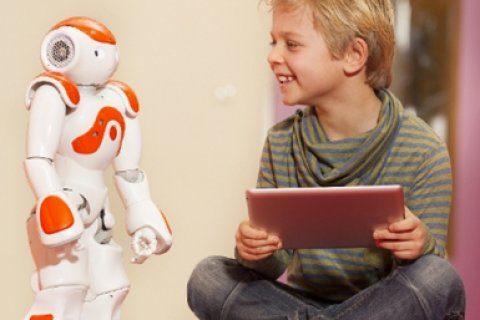Bringing expertise together! Combating low literacy with Artificial Intelligence in the ELSA lab
The Dutch AI Coalition has awarded the AI Approach to low literacy ELSA lab its NL AIC Label. Assistant Professor Hans Marien (Social, Health and Organisational Psychology) has been part of the lab since the very start. He has ambitious plans to expand it and combat low literacy with artificial intelligence.

ELSA stands for Ethical, Legal and Social Aspects; the NL AIC Label indicates that the AI Approach to low literacy lab meets the criteria formulated by the NL AIC for these aspects. As Hans Marien puts it, “This label constitutes recognition that what we are doing in the ELSA lab in the area of low literacy is reliable, that it has been properly regulated from a legal point of view, that the data are secure and so on. The latter is particularly important in human-centered Artificial Intelligence, because you collect a lot of sensitive data about people.”
AI Approach to low literacy lab
Low literacy is a growing social problem in the Netherlands. Hans Marien: “The topic is receiving a lot of attention, and a wide range of help is available. However, human-centered Artificial Intelligence (AI) has not yet been used for this purpose. By means of this ELSA lab, we want to find out how we can develop AI in such a way that it can be used to tackle the low literacy problem.”
Collaboration
The fact that the lab now has this label is mainly attributable to the UU focus area Human-centered Artificial Intelligence and the HUMAN-AI alliance with Eindhoven University of Technology. However, the cooperation goes much further than that, says Hans Marien, “The lab consists of a consortium of knowledge institutions, foundations, government bodies and companies. Personally, I represent the Psychology department of Utrecht University; we contribute knowledge about social cognition in general and social robots in particular. How do people deal with artificial intelligence? How do you ensure that someone has enough confidence to talk to a robot or app? Other participants in the lab have different areas of expertise. For example, we work with lawyers from Leiden University, an ethicist from Radboud University and speech technologists and robotics experts from the University of Twente. Fontys Eindhoven is participating with two professorships. The consortium also includes the municipality of Eindhoven, the Royal Library, the Reading and Writing Foundation, Stichting ABC (the ABC foundation, a voluntary organisation for people with low levels of literacy) and others. We have spoken with all these organisations.”
Although there are probably over 2.5 million Dutch people with low literacy, less than 10% are ‘found'
Co-design and co-creation
The important thing now is to use co-design and co-creation to create technology, such as speech technology that is better at identifying low literacy. Detection rates could be much better, says Hans Marien. “Although there are probably over 2.5 million Dutch people with low literacy, less than 10% are ‘found’. I am leading a study on how to use speech recognition data to detect whether someone can read and write well. Marijn Schraagen, a computational linguist, is responsible for the technology, and together with the other consortium partners, we are thinking about the design of the study and psychological factors.”
Speech to text
Wait stop hold. Could you look at how someone talks to find out how well they can read and write? Here is an example of how this could work. “Take speech-to-text technology: you dictate something, and your words appear on the screen. I’m going to use this to set up an experiment for young people: can you recognise your own spoken language when it is written down? If that is difficult, the person might not be particularly good at reading. Or you can research which words a person often uses when they are talking. If the person does not recognise these words in their written form, that is a clue. Or you could have a conversation about a particular text read out loud. That tells us something about a person’s vocabulary.”
Intervention and assistance
Hans Marien has been working in the ELSA lab for a year now. In addition to identifying low literacy, he also wants to investigate how you can use AI in interventions. For example, this could take the form of identifying a person's learning needs so that the range of assistance offered ties in better with their intrinsic motivation. Technology can also offer opportunities for assistance. “Some people with low levels of literacy are not ‘teachable’. These include people with intellectual disabilities or severe dyslexia, for example. Speech technology can help them with things like understanding texts and completing forms. But what if someone is also unable to speak well; how do you make important information accessible in that case?”
Financing
As a result, there is a large amount of new territory to be explored from the ELSA lab as a national collection point. Money is required for this. “Utrecht University has received funding for the identification survey among 12-to-15-year-old pupils. We will also shortly be submitting another grant application to the Dutch Research Council (NWO).” Unfortunately, the funding is spread thin. However: “Companies often have social agendas, and they need use cases. For example, there is a company that creates learning environments for children to teach them to read. They are now also going to make them accessible to older young people and adults.”

